BMP4005 Information Systems and Big Data Analysis Report 2019/2020
VerifiedAdded on 2021/06/11
|9
|3501
|77
Report
AI Summary
This report examines various aspects of information systems and big data analysis within a business management context. It begins by exploring theories, methods, and techniques related to the design and development of IT solutions, focusing on MS Office and Moodle. The report then delves into the explanation of key systems such as Decision Support Systems (DSS), Executive Support Systems (ESS), Transaction Processing Systems (TPS), Management Information Systems (MIS), and Knowledge Management Systems (KMS), providing relevant examples for each. The impact of globalization on IT and vice versa is discussed, followed by an analysis of digital infrastructure, including its advantages and disadvantages. Finally, the report addresses the risks associated with information systems outsourcing and highlights the critical role of IT infrastructure in digital transformation, concluding with a comprehensive overview of the subject matter.
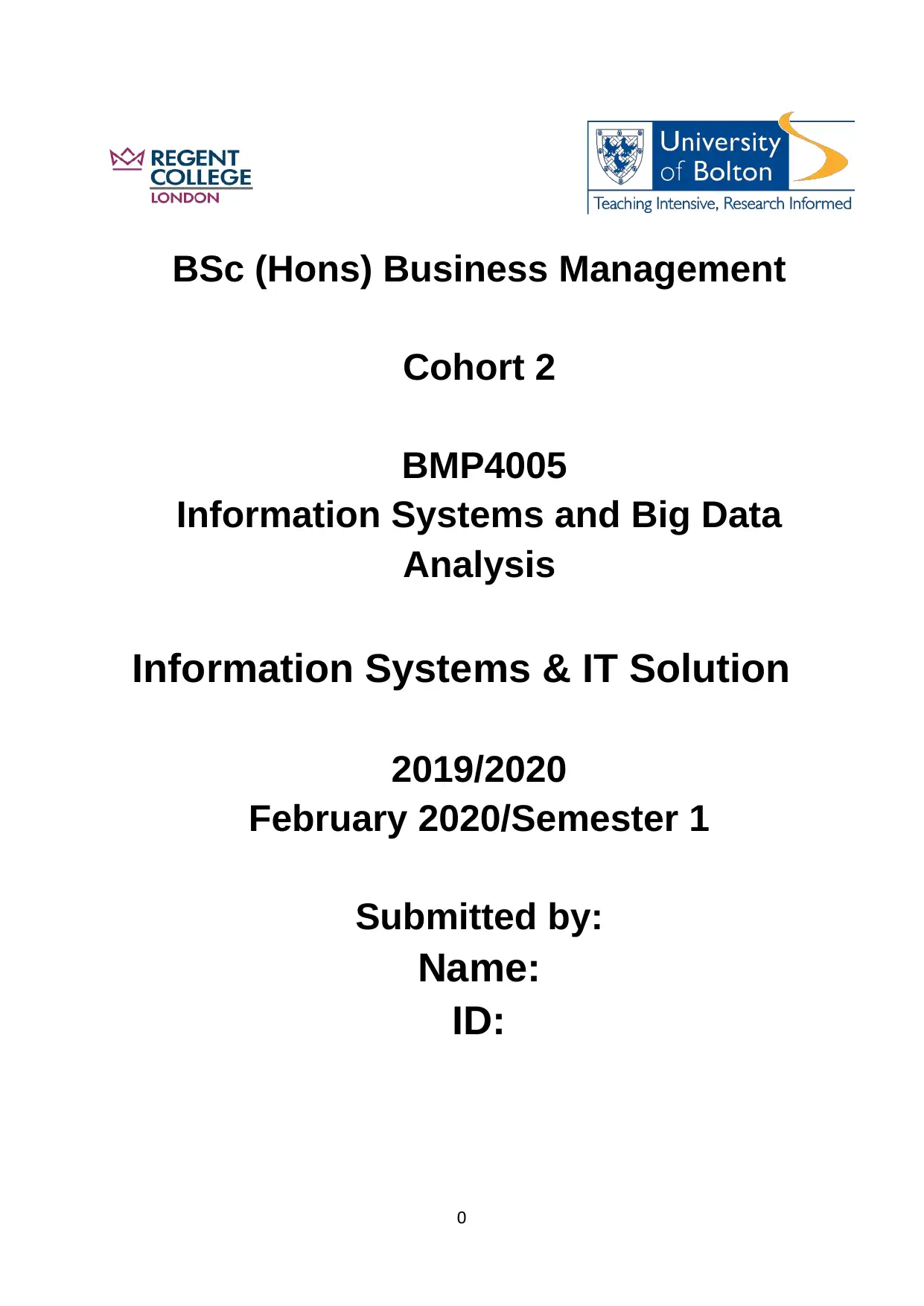
BSc (Hons) Business Management
Cohort 2
BMP4005
Information Systems and Big Data
Analysis
Information Systems & IT Solution
2019/2020
February 2020/Semester 1
Submitted by:
Name:
ID:
0
Cohort 2
BMP4005
Information Systems and Big Data
Analysis
Information Systems & IT Solution
2019/2020
February 2020/Semester 1
Submitted by:
Name:
ID:
0
Paraphrase This Document
Need a fresh take? Get an instant paraphrase of this document with our AI Paraphraser
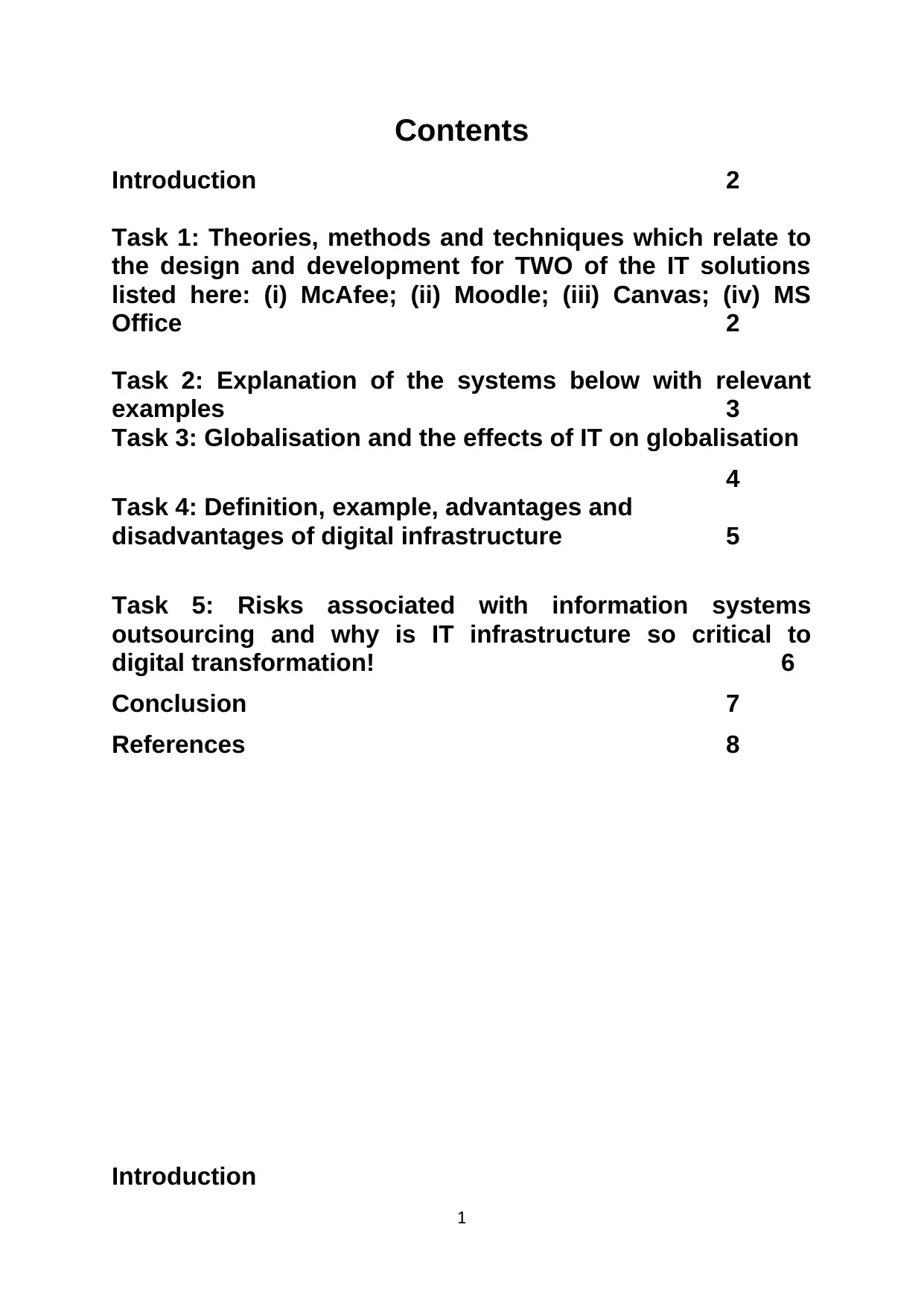
Contents
Introduction 2
Task 1: Theories, methods and techniques which relate to
the design and development for TWO of the IT solutions
listed here: (i) McAfee; (ii) Moodle; (iii) Canvas; (iv) MS
Office 2
Task 2: Explanation of the systems below with relevant
examples 3
Task 3: Globalisation and the effects of IT on globalisation
4
Task 4: Definition, example, advantages and
disadvantages of digital infrastructure 5
Task 5: Risks associated with information systems
outsourcing and why is IT infrastructure so critical to
digital transformation! 6
Conclusion 7
References 8
Introduction
1
Introduction 2
Task 1: Theories, methods and techniques which relate to
the design and development for TWO of the IT solutions
listed here: (i) McAfee; (ii) Moodle; (iii) Canvas; (iv) MS
Office 2
Task 2: Explanation of the systems below with relevant
examples 3
Task 3: Globalisation and the effects of IT on globalisation
4
Task 4: Definition, example, advantages and
disadvantages of digital infrastructure 5
Task 5: Risks associated with information systems
outsourcing and why is IT infrastructure so critical to
digital transformation! 6
Conclusion 7
References 8
Introduction
1
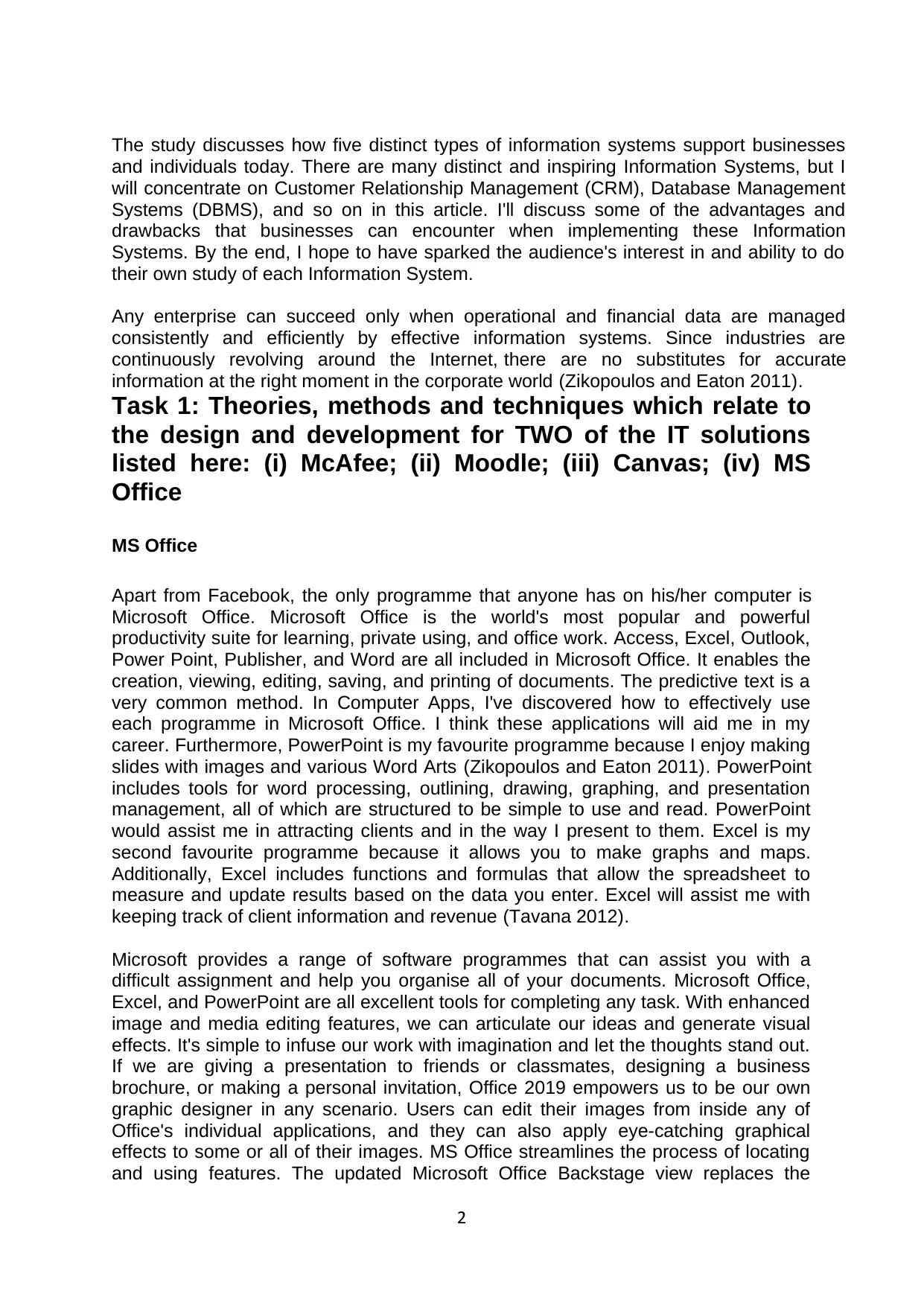
The study discusses how five distinct types of information systems support businesses
and individuals today. There are many distinct and inspiring Information Systems, but I
will concentrate on Customer Relationship Management (CRM), Database Management
Systems (DBMS), and so on in this article. I'll discuss some of the advantages and
drawbacks that businesses can encounter when implementing these Information
Systems. By the end, I hope to have sparked the audience's interest in and ability to do
their own study of each Information System.
Any enterprise can succeed only when operational and financial data are managed
consistently and efficiently by effective information systems. Since industries are
continuously revolving around the Internet, there are no substitutes for accurate
information at the right moment in the corporate world (Zikopoulos and Eaton 2011).
Task 1: Theories, methods and techniques which relate to
the design and development for TWO of the IT solutions
listed here: (i) McAfee; (ii) Moodle; (iii) Canvas; (iv) MS
Office
MS Office
Apart from Facebook, the only programme that anyone has on his/her computer is
Microsoft Office. Microsoft Office is the world's most popular and powerful
productivity suite for learning, private using, and office work. Access, Excel, Outlook,
Power Point, Publisher, and Word are all included in Microsoft Office. It enables the
creation, viewing, editing, saving, and printing of documents. The predictive text is a
very common method. In Computer Apps, I've discovered how to effectively use
each programme in Microsoft Office. I think these applications will aid me in my
career. Furthermore, PowerPoint is my favourite programme because I enjoy making
slides with images and various Word Arts (Zikopoulos and Eaton 2011). PowerPoint
includes tools for word processing, outlining, drawing, graphing, and presentation
management, all of which are structured to be simple to use and read. PowerPoint
would assist me in attracting clients and in the way I present to them. Excel is my
second favourite programme because it allows you to make graphs and maps.
Additionally, Excel includes functions and formulas that allow the spreadsheet to
measure and update results based on the data you enter. Excel will assist me with
keeping track of client information and revenue (Tavana 2012).
Microsoft provides a range of software programmes that can assist you with a
difficult assignment and help you organise all of your documents. Microsoft Office,
Excel, and PowerPoint are all excellent tools for completing any task. With enhanced
image and media editing features, we can articulate our ideas and generate visual
effects. It's simple to infuse our work with imagination and let the thoughts stand out.
If we are giving a presentation to friends or classmates, designing a business
brochure, or making a personal invitation, Office 2019 empowers us to be our own
graphic designer in any scenario. Users can edit their images from inside any of
Office's individual applications, and they can also apply eye-catching graphical
effects to some or all of their images. MS Office streamlines the process of locating
and using features. The updated Microsoft Office Backstage view replaces the
2
and individuals today. There are many distinct and inspiring Information Systems, but I
will concentrate on Customer Relationship Management (CRM), Database Management
Systems (DBMS), and so on in this article. I'll discuss some of the advantages and
drawbacks that businesses can encounter when implementing these Information
Systems. By the end, I hope to have sparked the audience's interest in and ability to do
their own study of each Information System.
Any enterprise can succeed only when operational and financial data are managed
consistently and efficiently by effective information systems. Since industries are
continuously revolving around the Internet, there are no substitutes for accurate
information at the right moment in the corporate world (Zikopoulos and Eaton 2011).
Task 1: Theories, methods and techniques which relate to
the design and development for TWO of the IT solutions
listed here: (i) McAfee; (ii) Moodle; (iii) Canvas; (iv) MS
Office
MS Office
Apart from Facebook, the only programme that anyone has on his/her computer is
Microsoft Office. Microsoft Office is the world's most popular and powerful
productivity suite for learning, private using, and office work. Access, Excel, Outlook,
Power Point, Publisher, and Word are all included in Microsoft Office. It enables the
creation, viewing, editing, saving, and printing of documents. The predictive text is a
very common method. In Computer Apps, I've discovered how to effectively use
each programme in Microsoft Office. I think these applications will aid me in my
career. Furthermore, PowerPoint is my favourite programme because I enjoy making
slides with images and various Word Arts (Zikopoulos and Eaton 2011). PowerPoint
includes tools for word processing, outlining, drawing, graphing, and presentation
management, all of which are structured to be simple to use and read. PowerPoint
would assist me in attracting clients and in the way I present to them. Excel is my
second favourite programme because it allows you to make graphs and maps.
Additionally, Excel includes functions and formulas that allow the spreadsheet to
measure and update results based on the data you enter. Excel will assist me with
keeping track of client information and revenue (Tavana 2012).
Microsoft provides a range of software programmes that can assist you with a
difficult assignment and help you organise all of your documents. Microsoft Office,
Excel, and PowerPoint are all excellent tools for completing any task. With enhanced
image and media editing features, we can articulate our ideas and generate visual
effects. It's simple to infuse our work with imagination and let the thoughts stand out.
If we are giving a presentation to friends or classmates, designing a business
brochure, or making a personal invitation, Office 2019 empowers us to be our own
graphic designer in any scenario. Users can edit their images from inside any of
Office's individual applications, and they can also apply eye-catching graphical
effects to some or all of their images. MS Office streamlines the process of locating
and using features. The updated Microsoft Office Backstage view replaces the
2
⊘ This is a preview!⊘
Do you want full access?
Subscribe today to unlock all pages.

Trusted by 1+ million students worldwide
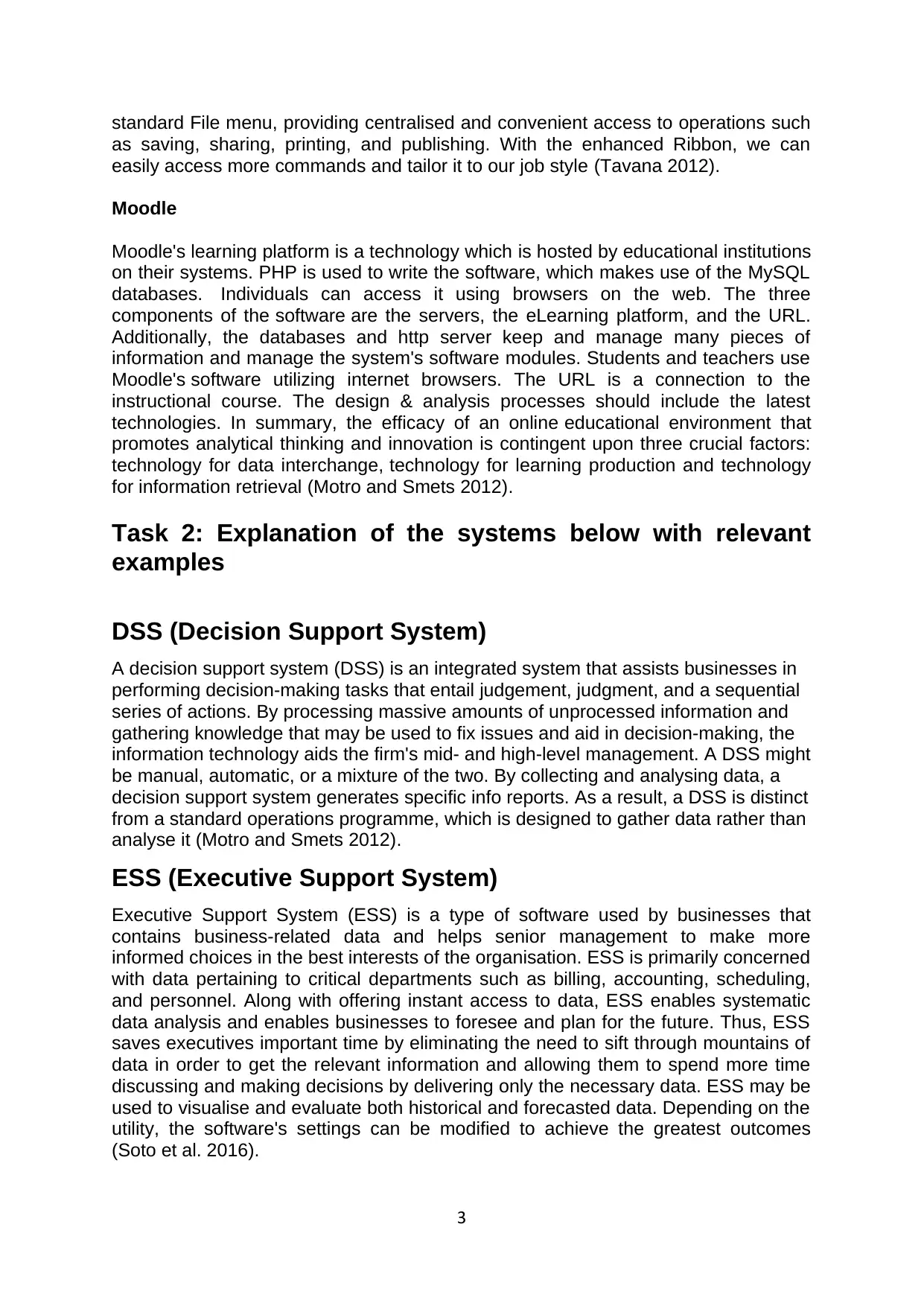
standard File menu, providing centralised and convenient access to operations such
as saving, sharing, printing, and publishing. With the enhanced Ribbon, we can
easily access more commands and tailor it to our job style (Tavana 2012).
Moodle
Moodle's learning platform is a technology which is hosted by educational institutions
on their systems. PHP is used to write the software, which makes use of the MySQL
databases. Individuals can access it using browsers on the web. The three
components of the software are the servers, the eLearning platform, and the URL.
Additionally, the databases and http server keep and manage many pieces of
information and manage the system's software modules. Students and teachers use
Moodle's software utilizing internet browsers. The URL is a connection to the
instructional course. The design & analysis processes should include the latest
technologies. In summary, the efficacy of an online educational environment that
promotes analytical thinking and innovation is contingent upon three crucial factors:
technology for data interchange, technology for learning production and technology
for information retrieval (Motro and Smets 2012).
Task 2: Explanation of the systems below with relevant
examples
DSS (Decision Support System)
A decision support system (DSS) is an integrated system that assists businesses in
performing decision-making tasks that entail judgement, judgment, and a sequential
series of actions. By processing massive amounts of unprocessed information and
gathering knowledge that may be used to fix issues and aid in decision-making, the
information technology aids the firm's mid- and high-level management. A DSS might
be manual, automatic, or a mixture of the two. By collecting and analysing data, a
decision support system generates specific info reports. As a result, a DSS is distinct
from a standard operations programme, which is designed to gather data rather than
analyse it (Motro and Smets 2012).
ESS (Executive Support System)
Executive Support System (ESS) is a type of software used by businesses that
contains business-related data and helps senior management to make more
informed choices in the best interests of the organisation. ESS is primarily concerned
with data pertaining to critical departments such as billing, accounting, scheduling,
and personnel. Along with offering instant access to data, ESS enables systematic
data analysis and enables businesses to foresee and plan for the future. Thus, ESS
saves executives important time by eliminating the need to sift through mountains of
data in order to get the relevant information and allowing them to spend more time
discussing and making decisions by delivering only the necessary data. ESS may be
used to visualise and evaluate both historical and forecasted data. Depending on the
utility, the software's settings can be modified to achieve the greatest outcomes
(Soto et al. 2016).
3
as saving, sharing, printing, and publishing. With the enhanced Ribbon, we can
easily access more commands and tailor it to our job style (Tavana 2012).
Moodle
Moodle's learning platform is a technology which is hosted by educational institutions
on their systems. PHP is used to write the software, which makes use of the MySQL
databases. Individuals can access it using browsers on the web. The three
components of the software are the servers, the eLearning platform, and the URL.
Additionally, the databases and http server keep and manage many pieces of
information and manage the system's software modules. Students and teachers use
Moodle's software utilizing internet browsers. The URL is a connection to the
instructional course. The design & analysis processes should include the latest
technologies. In summary, the efficacy of an online educational environment that
promotes analytical thinking and innovation is contingent upon three crucial factors:
technology for data interchange, technology for learning production and technology
for information retrieval (Motro and Smets 2012).
Task 2: Explanation of the systems below with relevant
examples
DSS (Decision Support System)
A decision support system (DSS) is an integrated system that assists businesses in
performing decision-making tasks that entail judgement, judgment, and a sequential
series of actions. By processing massive amounts of unprocessed information and
gathering knowledge that may be used to fix issues and aid in decision-making, the
information technology aids the firm's mid- and high-level management. A DSS might
be manual, automatic, or a mixture of the two. By collecting and analysing data, a
decision support system generates specific info reports. As a result, a DSS is distinct
from a standard operations programme, which is designed to gather data rather than
analyse it (Motro and Smets 2012).
ESS (Executive Support System)
Executive Support System (ESS) is a type of software used by businesses that
contains business-related data and helps senior management to make more
informed choices in the best interests of the organisation. ESS is primarily concerned
with data pertaining to critical departments such as billing, accounting, scheduling,
and personnel. Along with offering instant access to data, ESS enables systematic
data analysis and enables businesses to foresee and plan for the future. Thus, ESS
saves executives important time by eliminating the need to sift through mountains of
data in order to get the relevant information and allowing them to spend more time
discussing and making decisions by delivering only the necessary data. ESS may be
used to visualise and evaluate both historical and forecasted data. Depending on the
utility, the software's settings can be modified to achieve the greatest outcomes
(Soto et al. 2016).
3
Paraphrase This Document
Need a fresh take? Get an instant paraphrase of this document with our AI Paraphraser
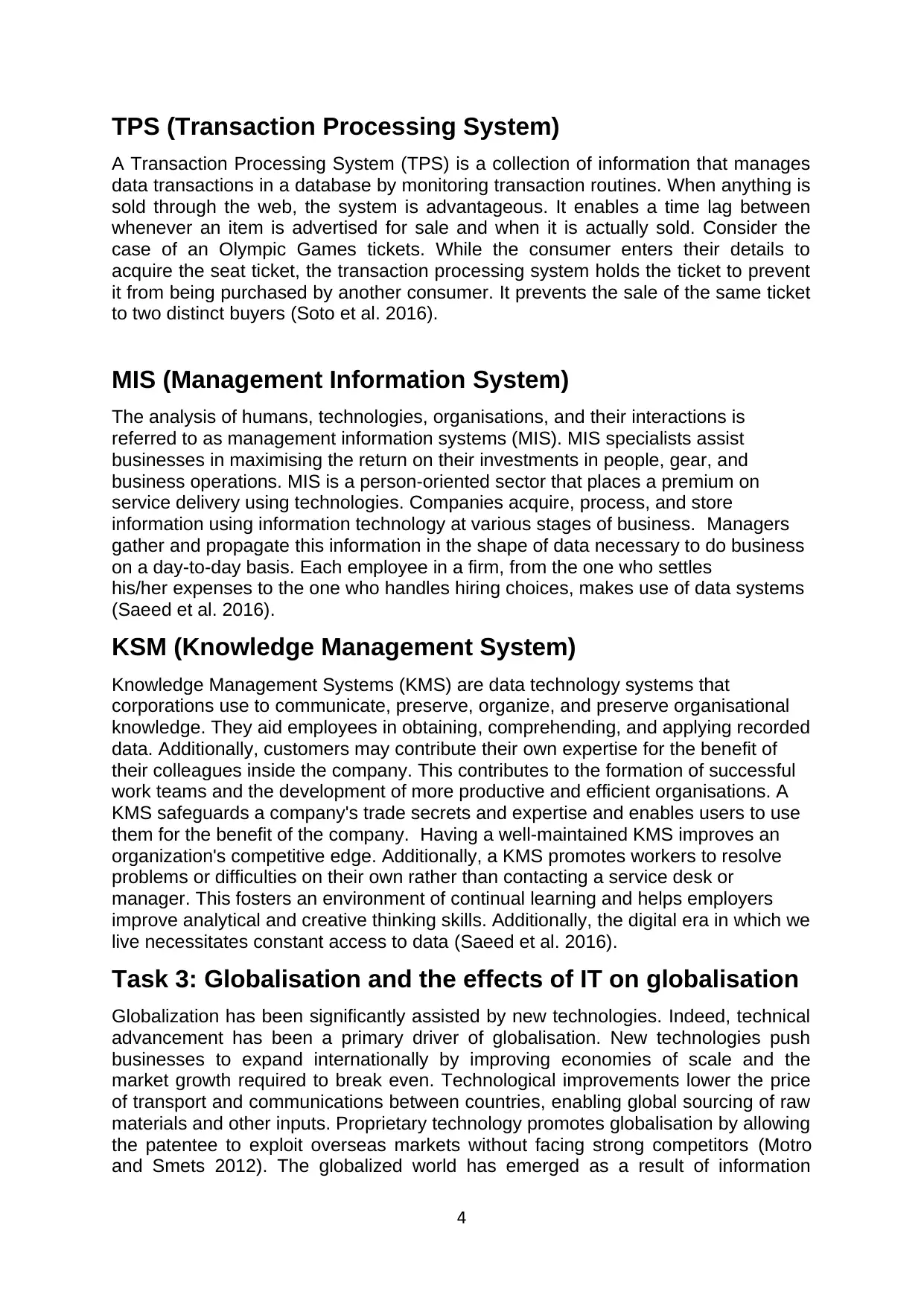
TPS (Transaction Processing System)
A Transaction Processing System (TPS) is a collection of information that manages
data transactions in a database by monitoring transaction routines. When anything is
sold through the web, the system is advantageous. It enables a time lag between
whenever an item is advertised for sale and when it is actually sold. Consider the
case of an Olympic Games tickets. While the consumer enters their details to
acquire the seat ticket, the transaction processing system holds the ticket to prevent
it from being purchased by another consumer. It prevents the sale of the same ticket
to two distinct buyers (Soto et al. 2016).
MIS (Management Information System)
The analysis of humans, technologies, organisations, and their interactions is
referred to as management information systems (MIS). MIS specialists assist
businesses in maximising the return on their investments in people, gear, and
business operations. MIS is a person-oriented sector that places a premium on
service delivery using technologies. Companies acquire, process, and store
information using information technology at various stages of business. Managers
gather and propagate this information in the shape of data necessary to do business
on a day-to-day basis. Each employee in a firm, from the one who settles
his/her expenses to the one who handles hiring choices, makes use of data systems
(Saeed et al. 2016).
KSM (Knowledge Management System)
Knowledge Management Systems (KMS) are data technology systems that
corporations use to communicate, preserve, organize, and preserve organisational
knowledge. They aid employees in obtaining, comprehending, and applying recorded
data. Additionally, customers may contribute their own expertise for the benefit of
their colleagues inside the company. This contributes to the formation of successful
work teams and the development of more productive and efficient organisations. A
KMS safeguards a company's trade secrets and expertise and enables users to use
them for the benefit of the company. Having a well-maintained KMS improves an
organization's competitive edge. Additionally, a KMS promotes workers to resolve
problems or difficulties on their own rather than contacting a service desk or
manager. This fosters an environment of continual learning and helps employers
improve analytical and creative thinking skills. Additionally, the digital era in which we
live necessitates constant access to data (Saeed et al. 2016).
Task 3: Globalisation and the effects of IT on globalisation
Globalization has been significantly assisted by new technologies. Indeed, technical
advancement has been a primary driver of globalisation. New technologies push
businesses to expand internationally by improving economies of scale and the
market growth required to break even. Technological improvements lower the price
of transport and communications between countries, enabling global sourcing of raw
materials and other inputs. Proprietary technology promotes globalisation by allowing
the patentee to exploit overseas markets without facing strong competitors (Motro
and Smets 2012). The globalized world has emerged as a result of information
4
A Transaction Processing System (TPS) is a collection of information that manages
data transactions in a database by monitoring transaction routines. When anything is
sold through the web, the system is advantageous. It enables a time lag between
whenever an item is advertised for sale and when it is actually sold. Consider the
case of an Olympic Games tickets. While the consumer enters their details to
acquire the seat ticket, the transaction processing system holds the ticket to prevent
it from being purchased by another consumer. It prevents the sale of the same ticket
to two distinct buyers (Soto et al. 2016).
MIS (Management Information System)
The analysis of humans, technologies, organisations, and their interactions is
referred to as management information systems (MIS). MIS specialists assist
businesses in maximising the return on their investments in people, gear, and
business operations. MIS is a person-oriented sector that places a premium on
service delivery using technologies. Companies acquire, process, and store
information using information technology at various stages of business. Managers
gather and propagate this information in the shape of data necessary to do business
on a day-to-day basis. Each employee in a firm, from the one who settles
his/her expenses to the one who handles hiring choices, makes use of data systems
(Saeed et al. 2016).
KSM (Knowledge Management System)
Knowledge Management Systems (KMS) are data technology systems that
corporations use to communicate, preserve, organize, and preserve organisational
knowledge. They aid employees in obtaining, comprehending, and applying recorded
data. Additionally, customers may contribute their own expertise for the benefit of
their colleagues inside the company. This contributes to the formation of successful
work teams and the development of more productive and efficient organisations. A
KMS safeguards a company's trade secrets and expertise and enables users to use
them for the benefit of the company. Having a well-maintained KMS improves an
organization's competitive edge. Additionally, a KMS promotes workers to resolve
problems or difficulties on their own rather than contacting a service desk or
manager. This fosters an environment of continual learning and helps employers
improve analytical and creative thinking skills. Additionally, the digital era in which we
live necessitates constant access to data (Saeed et al. 2016).
Task 3: Globalisation and the effects of IT on globalisation
Globalization has been significantly assisted by new technologies. Indeed, technical
advancement has been a primary driver of globalisation. New technologies push
businesses to expand internationally by improving economies of scale and the
market growth required to break even. Technological improvements lower the price
of transport and communications between countries, enabling global sourcing of raw
materials and other inputs. Proprietary technology promotes globalisation by allowing
the patentee to exploit overseas markets without facing strong competitors (Motro
and Smets 2012). The globalized world has emerged as a result of information
4
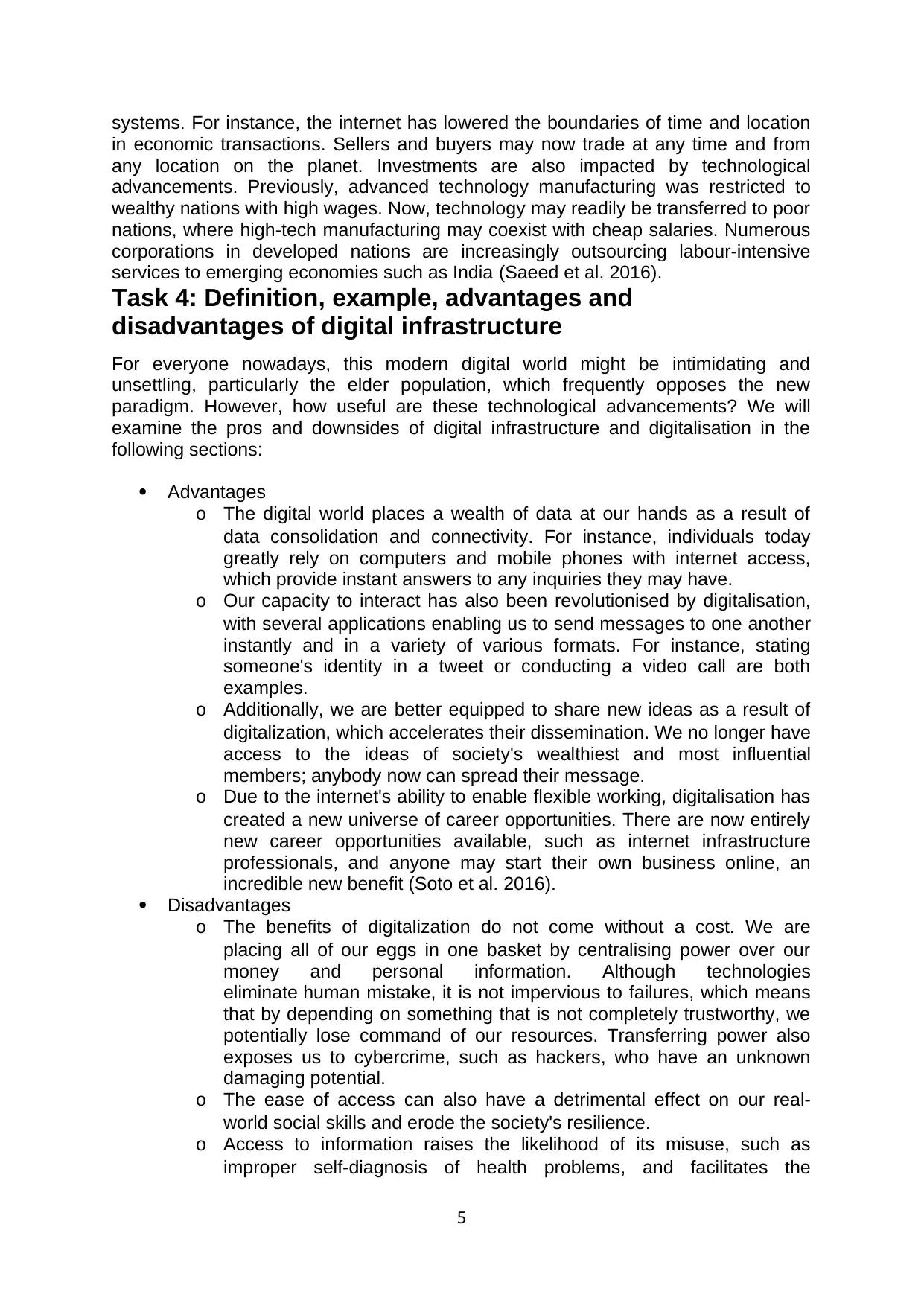
systems. For instance, the internet has lowered the boundaries of time and location
in economic transactions. Sellers and buyers may now trade at any time and from
any location on the planet. Investments are also impacted by technological
advancements. Previously, advanced technology manufacturing was restricted to
wealthy nations with high wages. Now, technology may readily be transferred to poor
nations, where high-tech manufacturing may coexist with cheap salaries. Numerous
corporations in developed nations are increasingly outsourcing labour-intensive
services to emerging economies such as India (Saeed et al. 2016).
Task 4: Definition, example, advantages and
disadvantages of digital infrastructure
For everyone nowadays, this modern digital world might be intimidating and
unsettling, particularly the elder population, which frequently opposes the new
paradigm. However, how useful are these technological advancements? We will
examine the pros and downsides of digital infrastructure and digitalisation in the
following sections:
Advantages
o The digital world places a wealth of data at our hands as a result of
data consolidation and connectivity. For instance, individuals today
greatly rely on computers and mobile phones with internet access,
which provide instant answers to any inquiries they may have.
o Our capacity to interact has also been revolutionised by digitalisation,
with several applications enabling us to send messages to one another
instantly and in a variety of various formats. For instance, stating
someone's identity in a tweet or conducting a video call are both
examples.
o Additionally, we are better equipped to share new ideas as a result of
digitalization, which accelerates their dissemination. We no longer have
access to the ideas of society's wealthiest and most influential
members; anybody now can spread their message.
o Due to the internet's ability to enable flexible working, digitalisation has
created a new universe of career opportunities. There are now entirely
new career opportunities available, such as internet infrastructure
professionals, and anyone may start their own business online, an
incredible new benefit (Soto et al. 2016).
Disadvantages
o The benefits of digitalization do not come without a cost. We are
placing all of our eggs in one basket by centralising power over our
money and personal information. Although technologies
eliminate human mistake, it is not impervious to failures, which means
that by depending on something that is not completely trustworthy, we
potentially lose command of our resources. Transferring power also
exposes us to cybercrime, such as hackers, who have an unknown
damaging potential.
o The ease of access can also have a detrimental effect on our real-
world social skills and erode the society's resilience.
o Access to information raises the likelihood of its misuse, such as
improper self-diagnosis of health problems, and facilitates the
5
in economic transactions. Sellers and buyers may now trade at any time and from
any location on the planet. Investments are also impacted by technological
advancements. Previously, advanced technology manufacturing was restricted to
wealthy nations with high wages. Now, technology may readily be transferred to poor
nations, where high-tech manufacturing may coexist with cheap salaries. Numerous
corporations in developed nations are increasingly outsourcing labour-intensive
services to emerging economies such as India (Saeed et al. 2016).
Task 4: Definition, example, advantages and
disadvantages of digital infrastructure
For everyone nowadays, this modern digital world might be intimidating and
unsettling, particularly the elder population, which frequently opposes the new
paradigm. However, how useful are these technological advancements? We will
examine the pros and downsides of digital infrastructure and digitalisation in the
following sections:
Advantages
o The digital world places a wealth of data at our hands as a result of
data consolidation and connectivity. For instance, individuals today
greatly rely on computers and mobile phones with internet access,
which provide instant answers to any inquiries they may have.
o Our capacity to interact has also been revolutionised by digitalisation,
with several applications enabling us to send messages to one another
instantly and in a variety of various formats. For instance, stating
someone's identity in a tweet or conducting a video call are both
examples.
o Additionally, we are better equipped to share new ideas as a result of
digitalization, which accelerates their dissemination. We no longer have
access to the ideas of society's wealthiest and most influential
members; anybody now can spread their message.
o Due to the internet's ability to enable flexible working, digitalisation has
created a new universe of career opportunities. There are now entirely
new career opportunities available, such as internet infrastructure
professionals, and anyone may start their own business online, an
incredible new benefit (Soto et al. 2016).
Disadvantages
o The benefits of digitalization do not come without a cost. We are
placing all of our eggs in one basket by centralising power over our
money and personal information. Although technologies
eliminate human mistake, it is not impervious to failures, which means
that by depending on something that is not completely trustworthy, we
potentially lose command of our resources. Transferring power also
exposes us to cybercrime, such as hackers, who have an unknown
damaging potential.
o The ease of access can also have a detrimental effect on our real-
world social skills and erode the society's resilience.
o Access to information raises the likelihood of its misuse, such as
improper self-diagnosis of health problems, and facilitates the
5
⊘ This is a preview!⊘
Do you want full access?
Subscribe today to unlock all pages.

Trusted by 1+ million students worldwide
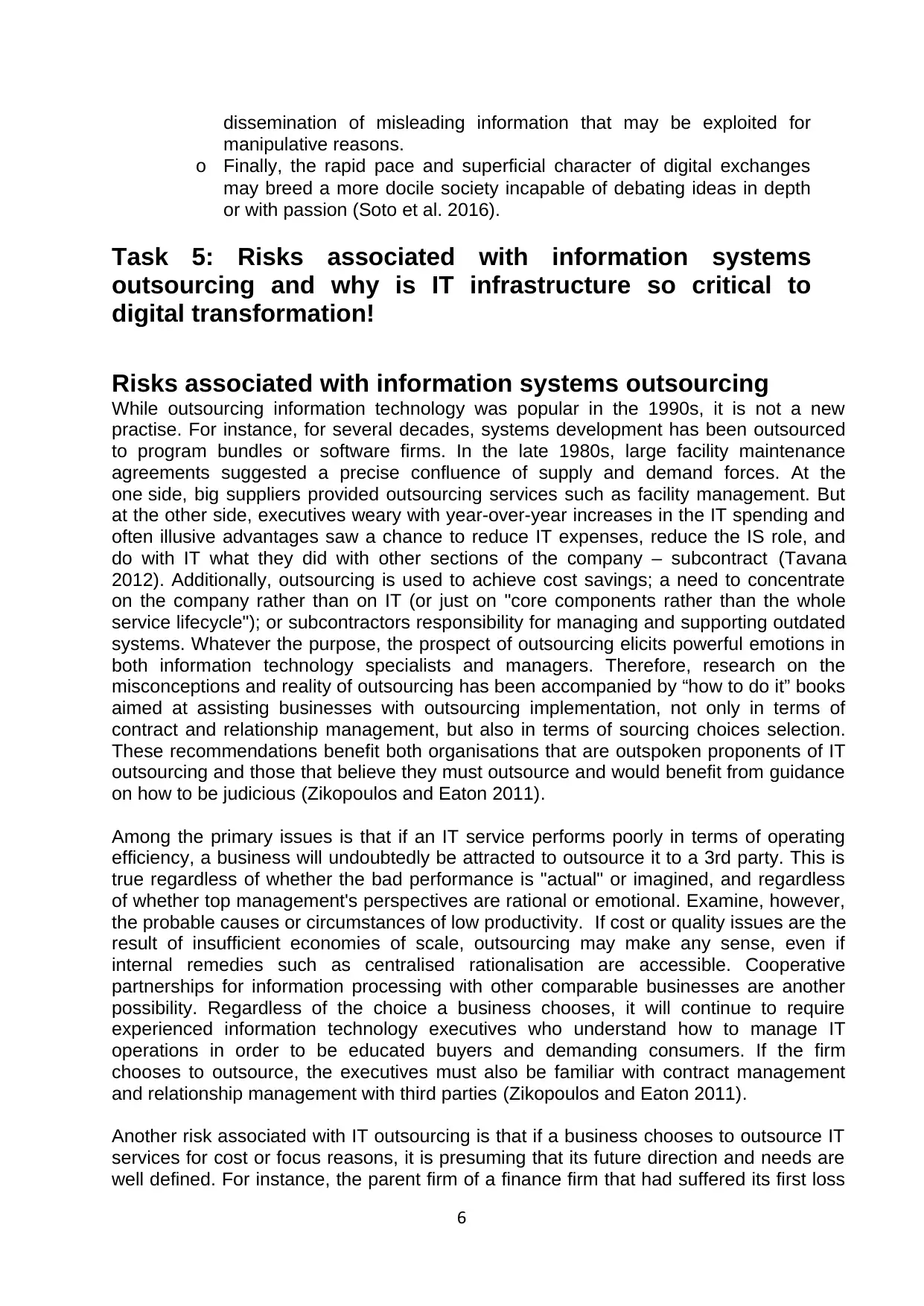
dissemination of misleading information that may be exploited for
manipulative reasons.
o Finally, the rapid pace and superficial character of digital exchanges
may breed a more docile society incapable of debating ideas in depth
or with passion (Soto et al. 2016).
Task 5: Risks associated with information systems
outsourcing and why is IT infrastructure so critical to
digital transformation!
Risks associated with information systems outsourcing
While outsourcing information technology was popular in the 1990s, it is not a new
practise. For instance, for several decades, systems development has been outsourced
to program bundles or software firms. In the late 1980s, large facility maintenance
agreements suggested a precise confluence of supply and demand forces. At the
one side, big suppliers provided outsourcing services such as facility management. But
at the other side, executives weary with year-over-year increases in the IT spending and
often illusive advantages saw a chance to reduce IT expenses, reduce the IS role, and
do with IT what they did with other sections of the company – subcontract (Tavana
2012). Additionally, outsourcing is used to achieve cost savings; a need to concentrate
on the company rather than on IT (or just on "core components rather than the whole
service lifecycle"); or subcontractors responsibility for managing and supporting outdated
systems. Whatever the purpose, the prospect of outsourcing elicits powerful emotions in
both information technology specialists and managers. Therefore, research on the
misconceptions and reality of outsourcing has been accompanied by “how to do it” books
aimed at assisting businesses with outsourcing implementation, not only in terms of
contract and relationship management, but also in terms of sourcing choices selection.
These recommendations benefit both organisations that are outspoken proponents of IT
outsourcing and those that believe they must outsource and would benefit from guidance
on how to be judicious (Zikopoulos and Eaton 2011).
Among the primary issues is that if an IT service performs poorly in terms of operating
efficiency, a business will undoubtedly be attracted to outsource it to a 3rd party. This is
true regardless of whether the bad performance is "actual" or imagined, and regardless
of whether top management's perspectives are rational or emotional. Examine, however,
the probable causes or circumstances of low productivity. If cost or quality issues are the
result of insufficient economies of scale, outsourcing may make any sense, even if
internal remedies such as centralised rationalisation are accessible. Cooperative
partnerships for information processing with other comparable businesses are another
possibility. Regardless of the choice a business chooses, it will continue to require
experienced information technology executives who understand how to manage IT
operations in order to be educated buyers and demanding consumers. If the firm
chooses to outsource, the executives must also be familiar with contract management
and relationship management with third parties (Zikopoulos and Eaton 2011).
Another risk associated with IT outsourcing is that if a business chooses to outsource IT
services for cost or focus reasons, it is presuming that its future direction and needs are
well defined. For instance, the parent firm of a finance firm that had suffered its first loss
6
manipulative reasons.
o Finally, the rapid pace and superficial character of digital exchanges
may breed a more docile society incapable of debating ideas in depth
or with passion (Soto et al. 2016).
Task 5: Risks associated with information systems
outsourcing and why is IT infrastructure so critical to
digital transformation!
Risks associated with information systems outsourcing
While outsourcing information technology was popular in the 1990s, it is not a new
practise. For instance, for several decades, systems development has been outsourced
to program bundles or software firms. In the late 1980s, large facility maintenance
agreements suggested a precise confluence of supply and demand forces. At the
one side, big suppliers provided outsourcing services such as facility management. But
at the other side, executives weary with year-over-year increases in the IT spending and
often illusive advantages saw a chance to reduce IT expenses, reduce the IS role, and
do with IT what they did with other sections of the company – subcontract (Tavana
2012). Additionally, outsourcing is used to achieve cost savings; a need to concentrate
on the company rather than on IT (or just on "core components rather than the whole
service lifecycle"); or subcontractors responsibility for managing and supporting outdated
systems. Whatever the purpose, the prospect of outsourcing elicits powerful emotions in
both information technology specialists and managers. Therefore, research on the
misconceptions and reality of outsourcing has been accompanied by “how to do it” books
aimed at assisting businesses with outsourcing implementation, not only in terms of
contract and relationship management, but also in terms of sourcing choices selection.
These recommendations benefit both organisations that are outspoken proponents of IT
outsourcing and those that believe they must outsource and would benefit from guidance
on how to be judicious (Zikopoulos and Eaton 2011).
Among the primary issues is that if an IT service performs poorly in terms of operating
efficiency, a business will undoubtedly be attracted to outsource it to a 3rd party. This is
true regardless of whether the bad performance is "actual" or imagined, and regardless
of whether top management's perspectives are rational or emotional. Examine, however,
the probable causes or circumstances of low productivity. If cost or quality issues are the
result of insufficient economies of scale, outsourcing may make any sense, even if
internal remedies such as centralised rationalisation are accessible. Cooperative
partnerships for information processing with other comparable businesses are another
possibility. Regardless of the choice a business chooses, it will continue to require
experienced information technology executives who understand how to manage IT
operations in order to be educated buyers and demanding consumers. If the firm
chooses to outsource, the executives must also be familiar with contract management
and relationship management with third parties (Zikopoulos and Eaton 2011).
Another risk associated with IT outsourcing is that if a business chooses to outsource IT
services for cost or focus reasons, it is presuming that its future direction and needs are
well defined. For instance, the parent firm of a finance firm that had suffered its first loss
6
Paraphrase This Document
Need a fresh take? Get an instant paraphrase of this document with our AI Paraphraser
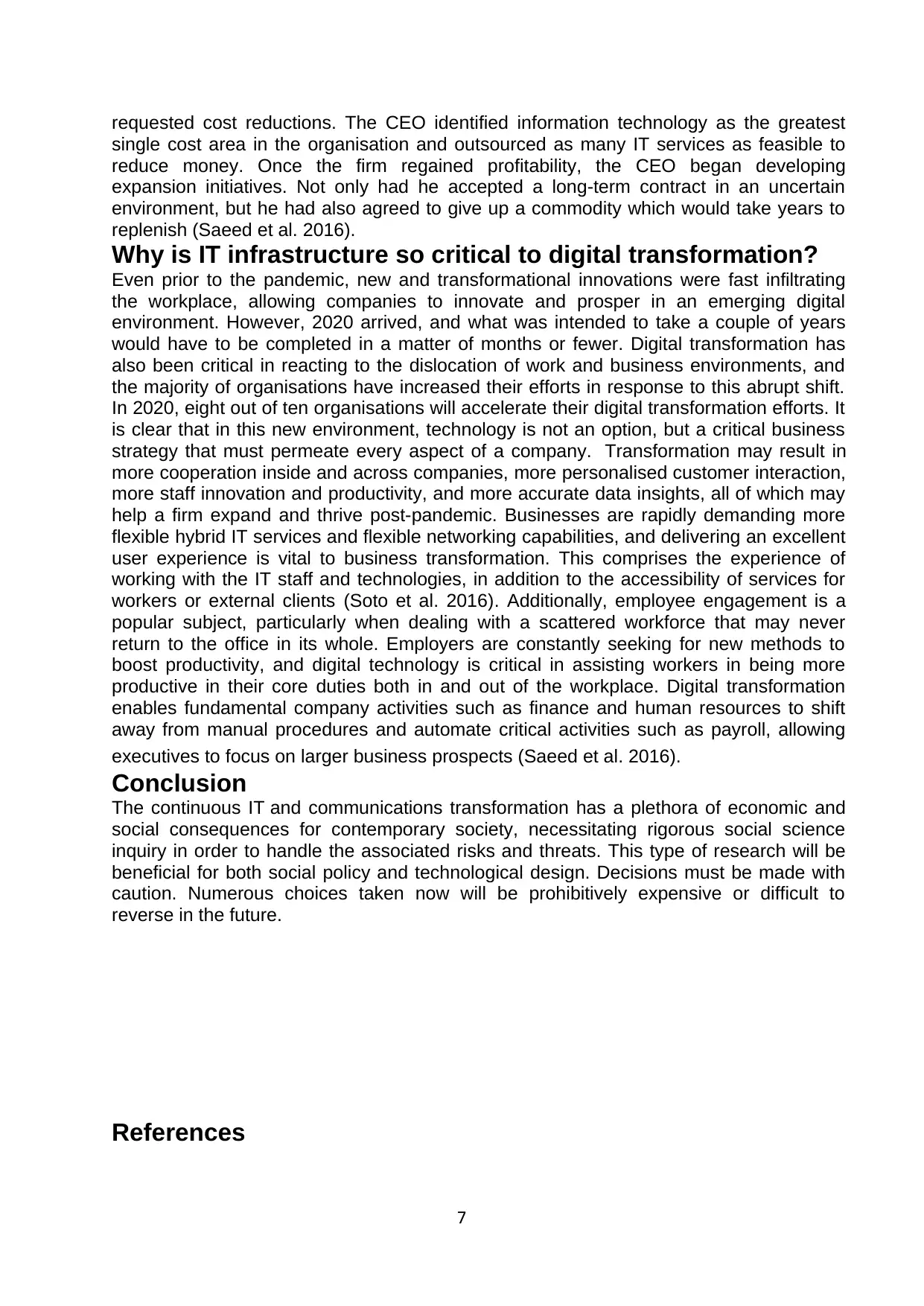
requested cost reductions. The CEO identified information technology as the greatest
single cost area in the organisation and outsourced as many IT services as feasible to
reduce money. Once the firm regained profitability, the CEO began developing
expansion initiatives. Not only had he accepted a long-term contract in an uncertain
environment, but he had also agreed to give up a commodity which would take years to
replenish (Saeed et al. 2016).
Why is IT infrastructure so critical to digital transformation?
Even prior to the pandemic, new and transformational innovations were fast infiltrating
the workplace, allowing companies to innovate and prosper in an emerging digital
environment. However, 2020 arrived, and what was intended to take a couple of years
would have to be completed in a matter of months or fewer. Digital transformation has
also been critical in reacting to the dislocation of work and business environments, and
the majority of organisations have increased their efforts in response to this abrupt shift.
In 2020, eight out of ten organisations will accelerate their digital transformation efforts. It
is clear that in this new environment, technology is not an option, but a critical business
strategy that must permeate every aspect of a company. Transformation may result in
more cooperation inside and across companies, more personalised customer interaction,
more staff innovation and productivity, and more accurate data insights, all of which may
help a firm expand and thrive post-pandemic. Businesses are rapidly demanding more
flexible hybrid IT services and flexible networking capabilities, and delivering an excellent
user experience is vital to business transformation. This comprises the experience of
working with the IT staff and technologies, in addition to the accessibility of services for
workers or external clients (Soto et al. 2016). Additionally, employee engagement is a
popular subject, particularly when dealing with a scattered workforce that may never
return to the office in its whole. Employers are constantly seeking for new methods to
boost productivity, and digital technology is critical in assisting workers in being more
productive in their core duties both in and out of the workplace. Digital transformation
enables fundamental company activities such as finance and human resources to shift
away from manual procedures and automate critical activities such as payroll, allowing
executives to focus on larger business prospects (Saeed et al. 2016).
Conclusion
The continuous IT and communications transformation has a plethora of economic and
social consequences for contemporary society, necessitating rigorous social science
inquiry in order to handle the associated risks and threats. This type of research will be
beneficial for both social policy and technological design. Decisions must be made with
caution. Numerous choices taken now will be prohibitively expensive or difficult to
reverse in the future.
References
7
single cost area in the organisation and outsourced as many IT services as feasible to
reduce money. Once the firm regained profitability, the CEO began developing
expansion initiatives. Not only had he accepted a long-term contract in an uncertain
environment, but he had also agreed to give up a commodity which would take years to
replenish (Saeed et al. 2016).
Why is IT infrastructure so critical to digital transformation?
Even prior to the pandemic, new and transformational innovations were fast infiltrating
the workplace, allowing companies to innovate and prosper in an emerging digital
environment. However, 2020 arrived, and what was intended to take a couple of years
would have to be completed in a matter of months or fewer. Digital transformation has
also been critical in reacting to the dislocation of work and business environments, and
the majority of organisations have increased their efforts in response to this abrupt shift.
In 2020, eight out of ten organisations will accelerate their digital transformation efforts. It
is clear that in this new environment, technology is not an option, but a critical business
strategy that must permeate every aspect of a company. Transformation may result in
more cooperation inside and across companies, more personalised customer interaction,
more staff innovation and productivity, and more accurate data insights, all of which may
help a firm expand and thrive post-pandemic. Businesses are rapidly demanding more
flexible hybrid IT services and flexible networking capabilities, and delivering an excellent
user experience is vital to business transformation. This comprises the experience of
working with the IT staff and technologies, in addition to the accessibility of services for
workers or external clients (Soto et al. 2016). Additionally, employee engagement is a
popular subject, particularly when dealing with a scattered workforce that may never
return to the office in its whole. Employers are constantly seeking for new methods to
boost productivity, and digital technology is critical in assisting workers in being more
productive in their core duties both in and out of the workplace. Digital transformation
enables fundamental company activities such as finance and human resources to shift
away from manual procedures and automate critical activities such as payroll, allowing
executives to focus on larger business prospects (Saeed et al. 2016).
Conclusion
The continuous IT and communications transformation has a plethora of economic and
social consequences for contemporary society, necessitating rigorous social science
inquiry in order to handle the associated risks and threats. This type of research will be
beneficial for both social policy and technological design. Decisions must be made with
caution. Numerous choices taken now will be prohibitively expensive or difficult to
reverse in the future.
References
7
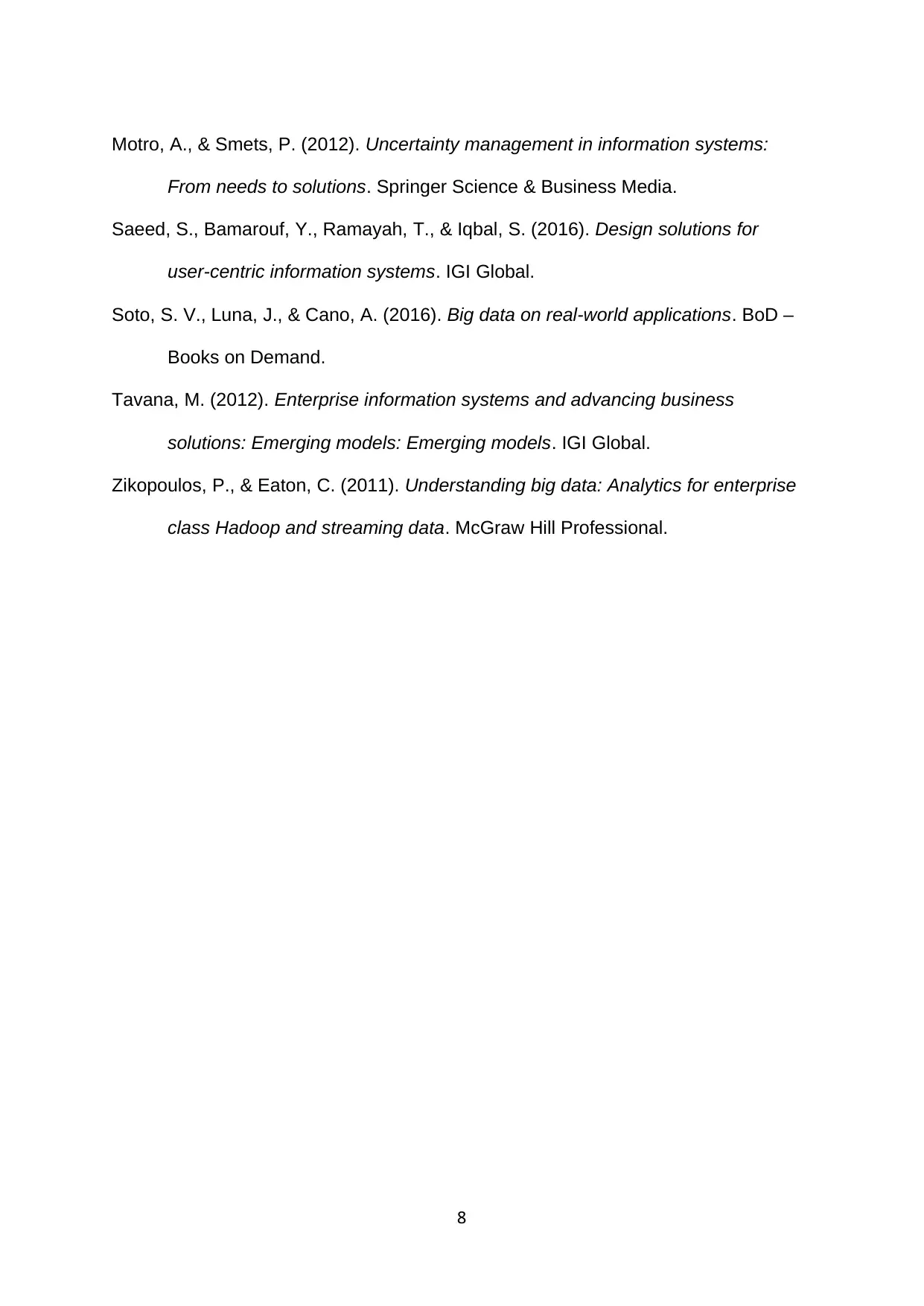
Motro, A., & Smets, P. (2012). Uncertainty management in information systems:
From needs to solutions. Springer Science & Business Media.
Saeed, S., Bamarouf, Y., Ramayah, T., & Iqbal, S. (2016). Design solutions for
user-centric information systems. IGI Global.
Soto, S. V., Luna, J., & Cano, A. (2016). Big data on real-world applications. BoD –
Books on Demand.
Tavana, M. (2012). Enterprise information systems and advancing business
solutions: Emerging models: Emerging models. IGI Global.
Zikopoulos, P., & Eaton, C. (2011). Understanding big data: Analytics for enterprise
class Hadoop and streaming data. McGraw Hill Professional.
8
From needs to solutions. Springer Science & Business Media.
Saeed, S., Bamarouf, Y., Ramayah, T., & Iqbal, S. (2016). Design solutions for
user-centric information systems. IGI Global.
Soto, S. V., Luna, J., & Cano, A. (2016). Big data on real-world applications. BoD –
Books on Demand.
Tavana, M. (2012). Enterprise information systems and advancing business
solutions: Emerging models: Emerging models. IGI Global.
Zikopoulos, P., & Eaton, C. (2011). Understanding big data: Analytics for enterprise
class Hadoop and streaming data. McGraw Hill Professional.
8
⊘ This is a preview!⊘
Do you want full access?
Subscribe today to unlock all pages.

Trusted by 1+ million students worldwide
1 out of 9
Related Documents
Your All-in-One AI-Powered Toolkit for Academic Success.
+13062052269
info@desklib.com
Available 24*7 on WhatsApp / Email
![[object Object]](/_next/static/media/star-bottom.7253800d.svg)
Unlock your academic potential
Copyright © 2020–2025 A2Z Services. All Rights Reserved. Developed and managed by ZUCOL.
